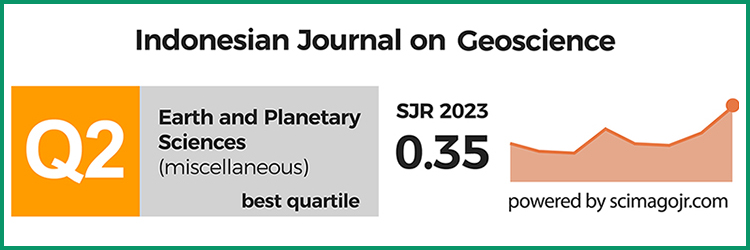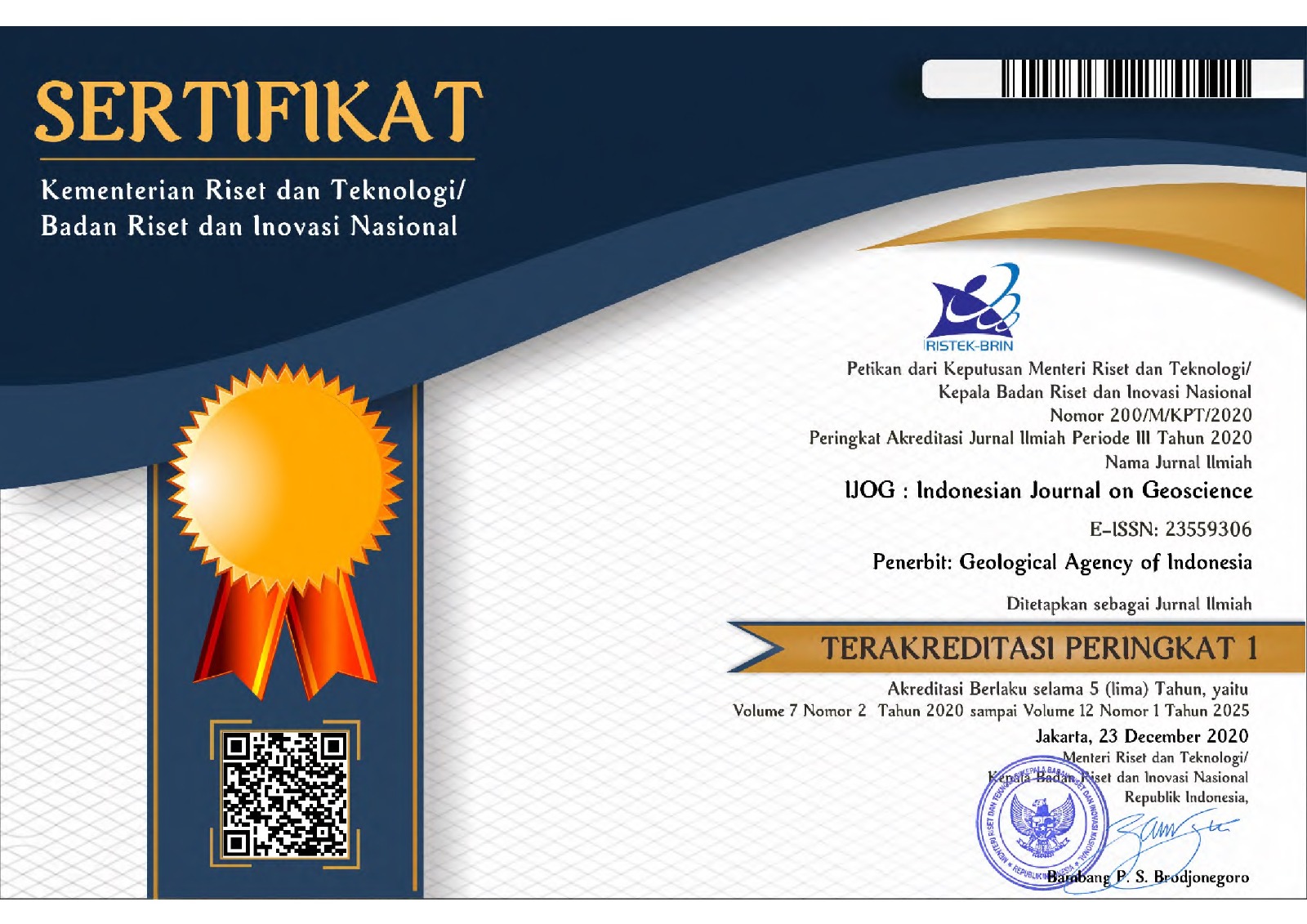Deformasi Gunung Kelud Pascapembentukan Kubah Lava November 2007
DOI:
https://doi.org/10.17014/ijog.5.1.13-30Keywords:
lava dome, deformation, GPS method, pressure source location, magma supply, injected magmaAbstract
The eruption of Kelud Volcano in 2007 was started with an increase in the seismic activity on September 2007. It was ended with a lava dome formation inside the crater lake on 3 November 2007. This phenomenon showed the change of eruption behavior compared to the last eruption on February 1990 that was an explosive one. Result from the GPS observation method during three periods, which are: April, August, and October 2008 showed that the vector displacement on each measured point was affected dominantly by structural geology forces as a crustal stabilisation after the last phase of November 2007 eruption. There was also a minor displacement as the result of magma migration around the points that were close to the lava dome. The magma migration occurred in a relatively shallow depth and was associated with an aseismic zone. The deformation that occurred as a result of magma migration toward the surface was calculated to determine the magma supply and magma injected. The result then was compared to illustrate a mechanism of deformation during April – October 2008. The comparison of magma supply and magma injected within these periods showed that the inflation still occurred, but it was not supported by a surface manifestation. This inflation could be false because of data discontinuity, or it is actually a part of deflation trend.
References
Bonaccorso, A. dan Davis, P.M., 1999. Model of ground deformation from Vertical Volcanic Conduits with Application to Eruptions of Mount St.Helens and Mount Etna. Journal Geophysics Research, 104(B5), h.10531-10542. DOI:10.1029/1999JB900054
Bonaccorso, A., 1996. Dynamic inversion of ground deformation data for modelling volcanic sources (Etna 1991-1993). Geophysics Research Letter, 23(5), h.4261-4268. DOI:10.1029/96GL00418
Dach, R., Hugentobler, U., Fridez, P., dan Meindl, M., 2007. Bernese GPS Software Version 5.0. Astronomical Institute, University of Bern.
Davis, P.M., Hastie, L.M., dan Stacey, F.D., 1974. Stresses within an active volcanoes: with particular reference to Kilauea. Tectonophysics, 22, h.363-375. DOI:10.1016/0040-1951(74)90091-2
Delaney, P.T. dan McTigue, D.F.,1994. Volume of magma accumulation or withdrawal estimated from surface uplift or subsidence, with application to the 1960 collapse of Kilauea volcano. Bulletin Vulcanology, 56, h.417-424. DOI:10.1007/BF00302823
Eaton, J.P., 1962. Crustal structure and volcanism in Hawaii. American Geophysic Union, Geophysic Monogram, 6, h.13-29.
Lisowski, M., 2007. Analytical Volcano Deformation Source Models. Dalam: Dzurisin, D., 2007. Volcano deformation, Geodetic monitoring techniques, Praxis publishing Ltd., Chichester, UK. DOI:10.1007/978-3-540-49302-0_8
Mogi, K., 1958. Relations between the eruptions of various volcanoes and the deformations of the ground surface around them. Bulletin of the Earthquake Research Institute, 36, h.99-134.
Nishi, K., Ono, H., dan Mori, H., 1998. Global positioning measurements of ground deformation caused by magma intrusion and lava discharge: the 1990-1995 eruption at Undenzake volcano, Kyushu, Japan. Journal of Volcanology and Geothermal Research, 89, h. 23-34. DOI:10.1016/S0377-0273(98)00119-X
Nishi, K., Hendrasto, M., Mulyana, I., Rosadi, U., dan Purbawinata, M.A., 2006. Micro-tilt changes prior to the summit explosions at Semeru volcano, Indonesia. Submitted for International Merapi Workshop, CVGHM, Yogyakarta. DOI:10.1186/BF03352688
Pratomo, I., 1992. Etude de l’eruption de 1990 du Volcan Kelut (Java Est-Indonesie): son apport a l’interpretation de l’activite historique du volcan. These, Universite Blaise Pascal, tidak dipublikasikan.
Rubin, A.M. dan Pollard, D.D., 1988. Dike- induced faulting in rift zones of Iceland and Afar. Geology, 16, h.413-417. DOI:10.1130/0091-7613(1988)016<0413:DIFIRZ>2.3.CO;2
Suantika, G., 2007. Laporan tanggap darurat letusan Gunung Kelud November 2007. Pusat Vulkanologi dan Mitigasi Bencana Geologi, Bandung.
Widiyantoro, S., 2004. Fisika Interior Bumi. Program Studi Geofisika, Institut Teknologi Bandung.
Wilson, L., 1980. Relationship between pressure, volatile content and ejecta velocity in three types of volcanic eruptions. Journal Volcanology and Geothermal Research, 8, h.297-313. DOI:10.1016/0377-0273(80)90110-9



















